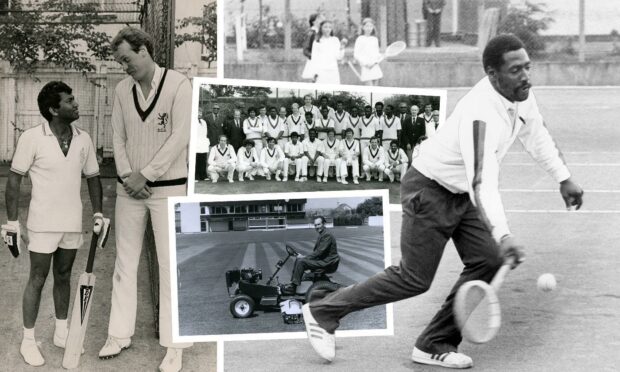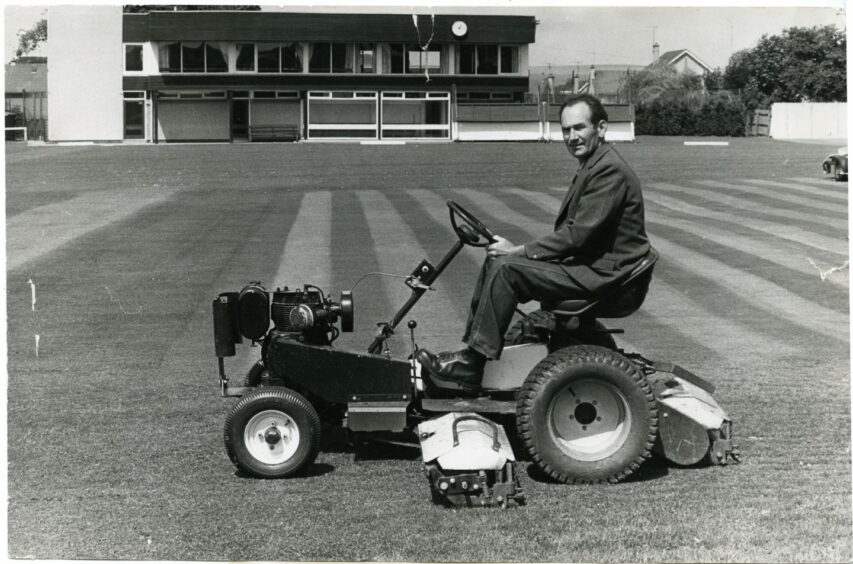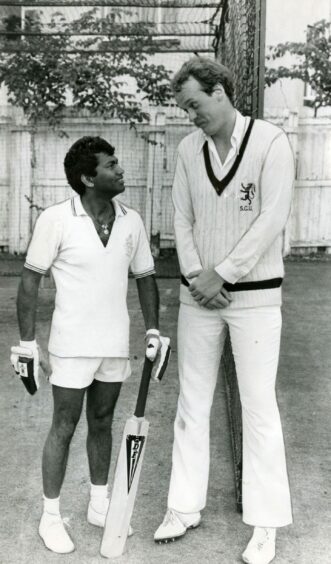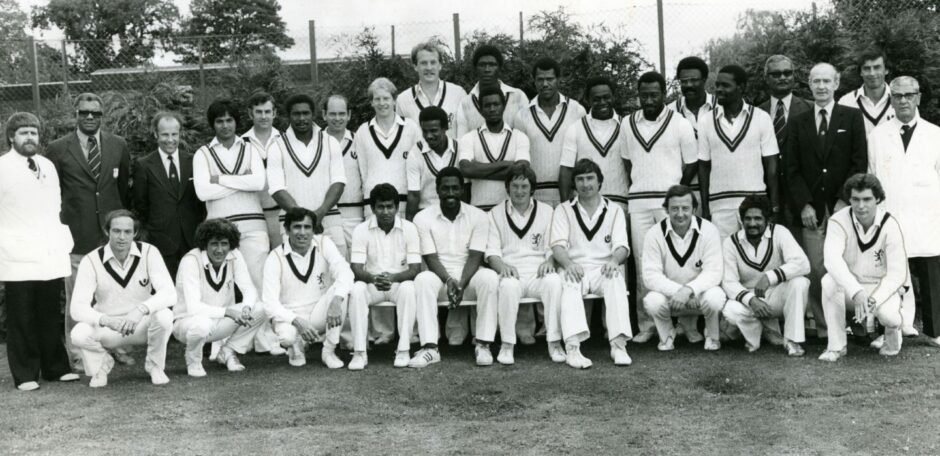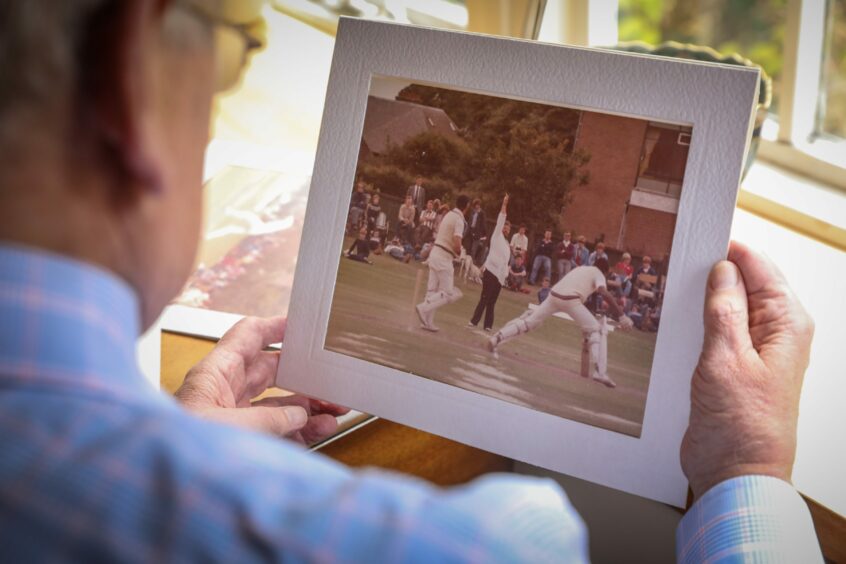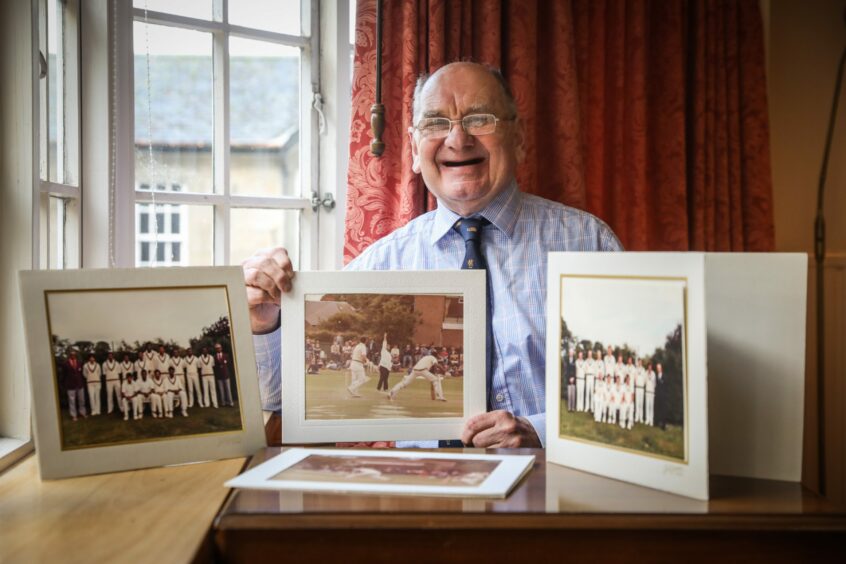For a certain generation, the late 1970s and early ’80s are something of a golden age of cricket.
Even if it was only to hear Richie Benaud on BBC Television’s test match coverage, a commentator par excellence whose Aussie tones and almost hypnotic on-camera demeanour sparked a thousand impersonations.
Or to listen to the ultra-dry and laconic Yorkshireman Jim Laker who joined him behind the microphone
And then, on radio, there was the incomparable and quintessential Englishman, John Arlott.
On the field at the time, it could be reasonably argued that the West Indies were the best team in the world.
And in July 1980 they were heading to Broughty Ferry.
The home of Forfarshire Cricket Club at Forthill had been chosen as the venue for a two day match between the “Windies” and Scotland.
It was an encounter which would see one of the greatest ever batsmen dragged off the tennis courts to play his innings, one of Forfarshire’s finest almost achieve an incredible cricketing hat-trick, and the visiting players being fortified by a local fish and chip shop.
West Indies superstars in Broughty Ferry
Forthill had staged eight internationals before the arrival of the West Indies, dating back to 1924.
But this was something else.
The men from the Caribbean had a team of genuine superstars.
Their line-up included dazzling batsmen like Gordon Greenidge, Desmond Haynes and the extravagantly gifted Viv Richards.
If the batsmen were a formidable force, the array of West Indies bowlers was a fearsome sight for opposition players.
Michael Holding, Andy Roberts, Malcolm Marshall, Colin Croft and Joel Garner could deliver the ball with murderous pace.
The West Indies had broken off from test matches and one-day internationals against England to travel north.
Their impending arrival caused a frisson of excitement at Forthill.
For those who met the West Indians, it was an unforgettable experience – and not just because of the cricket.
“I think as a club, the players and the people to do with the running of it were obviously very excited,” recalled Rae McLelland, a long-serving Forfarshire seam bowler.
“But it probably didn’t get quite the publicity it would get nowadays.”
However, to the huge frustration of everyone involved, the first day’s play on Thursday July 17 was a washout.
Rain stopped play after Gordon Greenidge and Desmond Haynes ran up a score of 70 for no wicket.
It was then decided to play a separate one-day game on the Friday.
Fish and chicken suppers
But events away from the cricket pitch became part of Forfarshire folklore.
“There was an amazing amount of work done by people at the club in preparation for the West Indies coming,” said Rae.
“But when their captain Clive Lloyd saw the lunch for the players being laid out on the first day when it was raining he said: ‘My boys don’t like salad’.
“It turned out they were meat and fish eaters.”
That was when club officials, probably John and Charles Allardyce, who both served as Forfarshire presidents, came to the rescue.
Arrangements were made for around 20 fish and chicken suppers to be ordered and delivered from a nearby chip shop.
“And my goodness, did these guys devour them,” said Rae.
Today’s sports scientists, fitness coaches and dieticians would not have approved and there were other signs that this was cricket in a different age.
The West Indians appeared to have a rather relaxed approach.
“These guys had an Australian trainer and from what I can remember, he had a bit of difficulty in getting them to warm up and limber up,” said Rae.
“It would be fair to say they were somewhat different from what you would expect a modern sports team to be.”
But no-one could question their talent and as the 50-over Friday match began before a sizeable crowd, Scotland’s players braced themselves for the onslaught.
Alex Steele
As it happened, the Scots did rather well and at one point a major shock was on the cards as they took four wickets for only 31 runs.
Forfarshire’s legendary wicketkeeper Alex Steele was playing for Scotland and it was a noteworthy day for him, to say the least.
Steele, who racked up 33 caps for Scotland, excelled and took a major scalp by stumping the outstanding batsman Desmond Haynes.
During his career, Haynes scored 7,487 runs in 116 test matches and made 18 test match centuries.
Only a few weeks before, he had a knock of 184 against England.
His score against Scotland at Forthill was five.
Alex still remembers the fine details of a moment that will live with him forever.
“Jack Clark was one of Scotland’s fast bowlers,” he said.
“It’s normally the case that wicket keepers stand back to quick bowlers but l noticed that Desmond Haynes moved out of his crease when he played the ball down the leg side.
“I told Jack and our captain Richard Swan that I was going to stand up to the stumps because of Desmond’s movements and very shortly after Jack pitched the ball eight or nine inches outside leg stump .
“Desmond missed the ball but moved out of his crease and l whipped the bails off.
“Euphoria!
“Desmond was out and it was one of the most magnificent feelings I’ve ever had.
“I’ve been told it was the only time Haynes had been stumped while playing for the West Indies!”
Tennis court
It was also an unforgettable moment for Gordon Walker, a Forfarshire off-spin bowler to this day.
He said: “Steelie stumped him and Haynes turned round to him and just said: ‘Man that was class'”
Alex also stumped Colin Croft later in the game but in between times he had a fair claim to have done the same to the great Viv Richards.
Sir Viv, as he became, was further down the West Indies batting order than normal but not for tactical reasons.
He was playing tennis on the adjacent courts at Forthill and word was he had told Clive Lloyd he wanted to finish his game before batting.
His masterful 69 helped the West Indies to win by 80 runs but the quick reflexes of Alex came close to stopping that happening.
However, he was denied in controversial fashion.
“I remember the Scottish lads had taken quite a number of quick wickets and the West Indies were not expecting that to happen and Viv Richards was on the tennis courts at the back of the club,” said Alex.
“There was a rapid change into his clothes and Viv came out to face bowler Willie Donald.
“Viv’s foot was on the line and I whipped the bails off and I just about disintegrated my vocal chords with the loudest appeal.
“Charlie Cormack was the umpire.
“He gave not out.
“There were about 3,000 people at the ground and he said: ‘Alex that was absolutely great but they haven’t come to see you keep wicket, they’ve come to see Viv Richards play so it was definitely not out’.
“I wasn’t a happy bunny.
“I was absolutely convinced he was out.”
But the consolation was stumping Haynes.
Now 80, it was Alex Steele’s “most precious moment in cricket” and he looks back on the day as “an absolutely marvellous experience.”
But after mingling with the players, the West Indies experience turned to the surreal for Gordon Walker when he was visited by the man known as Big Bird.
At six foot eight inches in height, Joel Garner was a physical colossus as well as a devastating bowler.
When he went into the pavilion at Forthill, he had to bend down to get his head below the wooden lintel above the bar.
Gordon, who was then living with his parents near the ground, had met the West Indies players during the day.
“About midnight my doorbell rang,” he said.
“When I opened the door all I could see was this maroon blazer, the West Indies colours.
“It was Joel Garner.
“He asked if it was okay for him to come in for a drink and he came in with Faoud Bacchus and Andy Roberts.
“Viv Richards was driving their car and he decided to go nightclubbing.
“Joel Garner sat on my father’s big armchair and they stayed until about four in the morning drinking gin and tonics!
“There were a few of the younger boys from the cricket team there. It was quite a special occasion for all of us.”
The West Indies players enamoured themselves to the Scots.
And the feeling was mutual.
On the pitch, the Scots managed to bowl out a truly formidable side and performed extremely well against the best bowling attack in the world at the time.
For the record, the West Indies were 233 all out while Scotland scored 153 for seven wickets after 50 overs.
The “special occasion” that Gordon Walker mentions is perhaps an understatement.
The two days that the West Indies came to Broughty Ferry were truly historic.
More like this:
Bermuda cricket hero Nigel Hazel fired Strathmore to success and fell in love with Forfar
Does north-east cricket have anything to learn from Yorkshire racism scandal?
